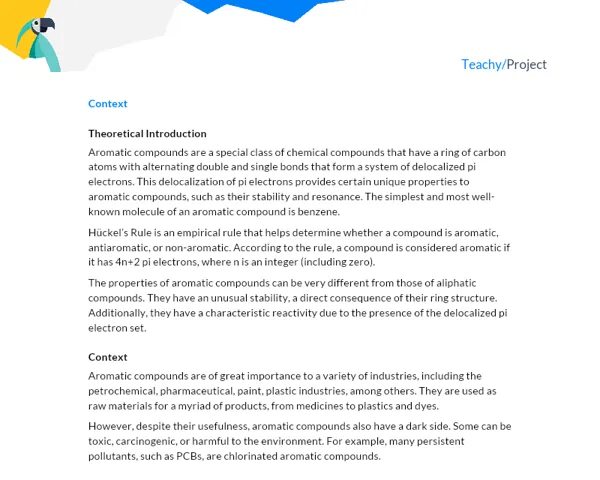Contextualization
Theoretical Introduction
Chemical bonds are forces that hold atoms together in compounds. Chemical bonds can be categorized into different types, such as ionic, covalent, and metallic bonds. Covalent bonds are formed when two atoms share electrons. These covalent bonds can be classified into sigma bonds and pi bonds, depending on the geometry of electron sharing.
Sigma bonds (σ) are formed when two atomic orbitals overlap linearly between the nuclei of the participating atoms. Therefore, they are stronger and more stable than pi bonds, as they have a larger overlapping area between the orbitals.
On the other hand, pi bonds (π) are formed by a lateral sharing of electrons, where the overlap occurs parallel to the nuclear axis. These bonds tend to be weaker than sigma bonds, precisely due to the smaller overlapping area.
Practical Application and Contextualization
The concepts of sigma and pi bonds are fundamental for understanding the structure and properties of molecules. For example, these bonds are essential for describing the flat structure of benzene, a molecule of crucial importance in organic chemistry and the pharmaceutical industry.
Furthermore, understanding these bonds is essential for describing chemical reactions, such as addition reactions in alkenes and alkynes. Manipulating these reactions is the basis of many organic syntheses, with applications ranging from fuels to medications.
Practical Activity
Activity Title: Building Molecular Models: Understanding Pi and Sigma Bonds
Project Objective:
The objective of this project is to provide a deep and practical understanding of sigma and pi bonds in the structure of molecules. Through the construction of molecular models, students will visualize and comprehend the difference between these two bonds. Students will also apply these concepts in a historical context, relating them to the evolution of scientific thought.
Detailed Project Description:
The project will involve students in groups of 3 to 5 people, and each group will need to develop the following components:
-
Research and Theoretical Presentation: each group must start a detailed research on pi and sigma bonds, exploring their theory, importance, and applications. Based on this research, the groups must prepare a slide show to present their findings and explain these concepts.
-
Building Molecular Models: using molecular modeling kits (or household materials, such as sticks and marbles), students must build models of molecules that demonstrate sigma and pi bonds. The goal here is to visualize and understand the difference between these two bonds.
-
Historical Contextualization: based on the research conducted, students should connect pi and sigma bonds with historical scientific advances, elaborating a written text.
These activities should be carried out over several weeks, estimating a total effort of at least 12 hours of work for each student.
Required Materials:
- Internet access for research
- Computer for preparing presentations
- Molecular modeling kits (or alternatively, sticks and marbles to build the models)
- Paper and pen for notes and writing the text
Detailed Step-by-Step for Activity Execution:
-
Research: Groups should start by researching pi and sigma bonds. Seeking to understand the theory behind these bonds and their importance in structuring molecules and in chemical reactions.
-
Presentation Preparation: Based on the research, groups should prepare a slide show explaining pi and sigma bonds. The presentation should include the theory, practical examples of molecules containing these bonds, and their practical implications and uses.
-
Building the Models: Using the molecular modeling kits, each group must build models of molecules that demonstrate both bonds. These models will be used during the presentations to assist in explaining the concept.
-
Historical Contextualization: Finally, each group must write a text connecting pi and sigma bonds with the evolution of scientific thought. They can address how the discovery of these bonds contributed to the current understanding of chemistry.
Project Deliverables:
At the end of the project, each group must deliver:
-
Slide Presentation: A slide presentation explaining the theory of sigma and pi bonds and demonstrating their understanding through practical examples.
-
Molecular Models: Physical models of molecules demonstrating sigma and pi bonds.
-
Written Text: A text that connects the theory of pi and sigma bonds with the evolution of scientific thought.
These deliverables will be complemented with the report where students will detail their research and learning processes, the concepts learned, the methodology used for building the models, and the conclusions drawn from the project.


